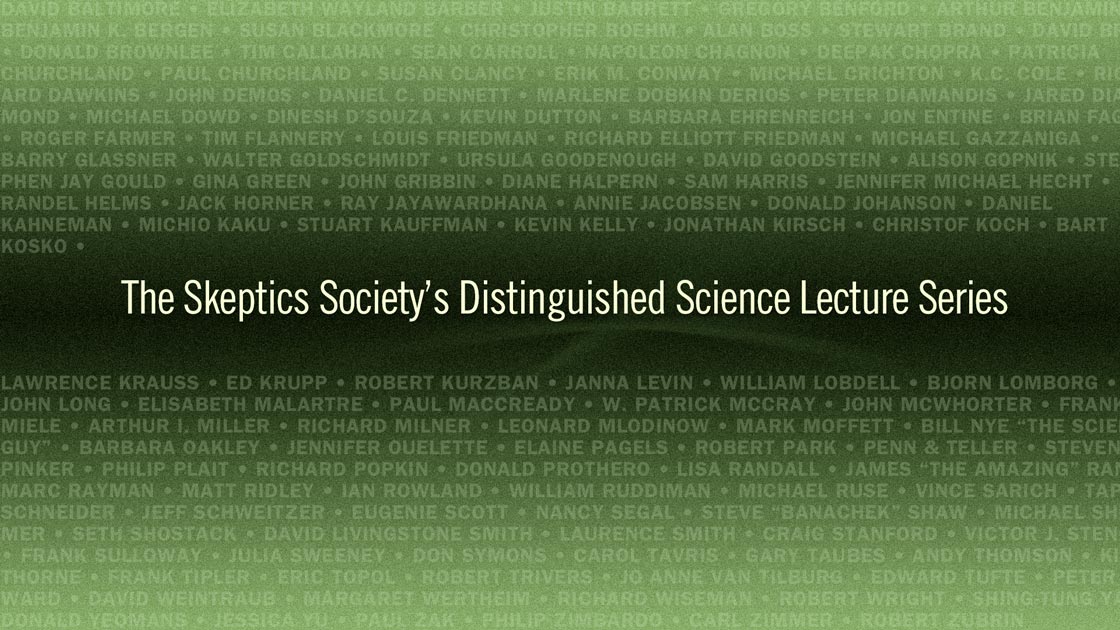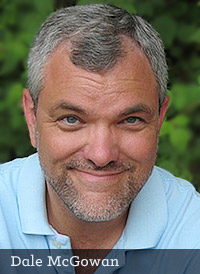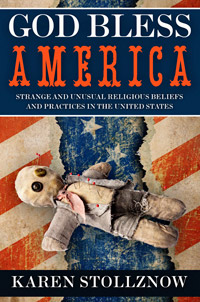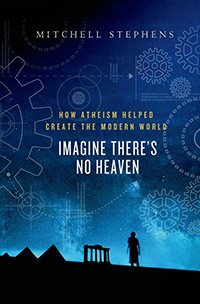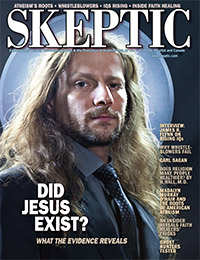In this week’s eSkeptic:
Our Next Science Lecture
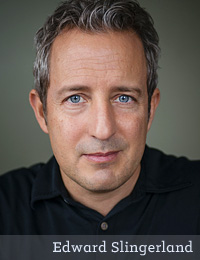
Trying Not to Try:
The Art and Science
of Spontaneity
with Dr. Edward Slingerland
Sun., Apr., 13, 2014 at 2 pm
Baxter Lecture Hall
WHY IS IT ALWAYS HARD to fall asleep the night before an important meeting? Or be charming and relaxed on a first date? What is it about a politician who seems wooden or a comedian whose jokes fall flat or an athlete who chokes? In all of these cases, striving seems to backfire. In Trying Not To Try, Edward Slingerland explains why we find spontaneity so elusive, and shows how early Chinese thought points the way to happier, more authentic lives. We’ve long been told that the way to achieve our goals is through careful reasoning and conscious effort. But recent research suggests that many aspects of a satisfying life, like happiness and spontaneity, are best pursued indirectly. Through stories of mythical creatures and drunken cart riders, jazz musicians and Japanese motorcycle gangs, Slingerland effortlessly blends Eastern thought and cutting-edge science to show us how we can live more fulfilling lives. Order Trying Not to Try from Amazon.
TICKETS are first come, first served at the door. Seating is limited. $10 for Skeptics Society members and the JPL/Caltech community, $15 for nonmembers. Your admission fee is a donation that pays for our lecture expenses.

God Bless America
Beyond Belief
SKEPTICALITY EPISODE 227
Since Skepticality took a break last episode, Derek comes back with two interviews to fill the void this past month. The first is with Dale McGowan: author, speaker, philanthropist, and founder of Foundation Beyond Belief. They discuss how the Foundation came to be, its current goals, and how people worldwide can get involved. After Dale, Derek has a discussion with Karen Stollznow: writer, linguist, and author of several books with a skeptical slant. One of Stollznow’s latest books, God Bless America, looks some unusual religious practices and beliefs across the United States of America.
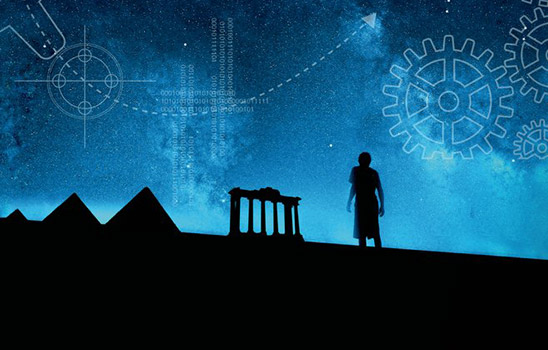
About this week’s eSkeptic
In this week’s eSkeptic, we present an excerpt from Mitchell Stephens’ new book, Imagine There’s No Heaven: How Atheism Helped Create the Modern World: a comprehensive history of atheism starting with the ancient Greeks. Michael Shermer called it “the most thorough chronicle to date” that he has read. We selected a portion of the book related directly to what led to the current state of unbelief in America and Western Europe today, but we encourage you to read the entire book to get the full context of what intellectual currents came before us. This excerpt has been reprinted with permission from Palgrave Macmillan, and appears in Skeptic magazine issue 19.1 (2014).
Mitchell Stephens is a historian and journalist who has been researching the history of atheism for a decade. A professor in the Arthur L. Carter Journalism Institute at New York University, his books include A History of News, a New York Times “Notable Book of the Year” and The Rise of the Image, the Fall of the Word. Professor Stephens is also the author of Broadcast News, the most widely used radio and television news textbook, and the co-author of Writing and Reporting the News. In recent years, he has written numerous articles on media issues and aspects of contemporary thought for publications such as the New York Times, the Los Angeles Times, the Washington Post and the Columbia Journalism Review. Professor Stephens has been history consultant to the Newseum in Washington D.C.
Share this article with friends online.
Subscribe | Donate | Watch Lectures | Shop
Imagine There’s No Heaven
The Seeds of Modern Atheism and the
Tragic Life of Madalyn Murray O’Hair
by Mitchell Stephens
Give me the storm and tempest of thought and action, rather than the dead calm of ignorance and faith! Banish me from Eden when you will, but first let me eat of the fruit of the tree of knowledge!
In August 1960, Madalyn Mays traveled to Paris with her two boys—one 14, the other five.2 Her purpose wasn’t to see sights or sit in cafés. Much of her time was spent at the Soviet Embassy. Mays’ efforts to obtain permission to emigrate to the Soviet Union had failed in Washington; she thought she might have better luck in Paris.
The United States had certainly lost its attraction for Mays. She was tired of its hypocritical morality, to which she hadn’t much bothered to conform: both her boys had different fathers, neither of whom was the man to whom she had, briefly, been married. “I see social mores that are wrong, stupid, immoral,” Mays fumes in her diary.3 She was tired, too, of America’s narrow, stifling politics. And Mays was furious that her eldest son, William Murray, Jr., had been forced—like many, probably most, public-school children in the United States—to read the Bible and say a prayer each morning in his Baltimore public school.4
All of these complaints would have been received sympathetically at the Café de Flore. But Mays had the disadvantage of being an aggressive woman a decade before the women’s movement (despite the best efforts of Simone de Beauvoir) got off the ground. She had been questioning conventional beliefs not on the Left Bank but in America, in the 1950s and early-1960s, where and when those who indulged in that sort of thing, male or female, were more likely to have the tires on their cars slashed and the windows on their houses smashed than to lecture before overflow crowds. France and the rest of Western Europe were beginning to accelerate their long slide away from religion. The United States, from which Madalyn Mays had fled, was not sliding in that direction in any obvious way—for reasons her story can help illuminate.
The fact that she couldn’t speak Russian did not help her case at the Soviet Embassy in Paris, nor did those two fatherless boys. Mays returned to Baltimore, further abashed. This was a woman who could put up with, and had to put up with, a lot of being abashed. She was 41, living with her parents and a failure by most of the standards of her society. However, Madalyn Murray—she had begun using her former lover’s last name—was on the verge of a large, notorious success. In October of 1960, she called Woodbourne Junior High and was transferred to an assistant superintendent. Some of the details of this story, as with much having to do with Murray’s life, are in dispute, but she says the call was made at her son William’s behest.5 Murray announced, on the phone, that William was going to stop participating in the school’s morning “devotionals”: readings from the King James Bible and recitation of the Lord’s Prayer. She asked that William be allowed to stay away from the room during these religious exercises. “This is part of our history and our culture…,” responded that assistant superintendent. He added: “I never had a request like this in my life.”6
However, such requests were beginning to be made. Students or parents were protesting religious readings with sufficient insistency to lead to legal action at three other schools in the United States in these years. Those cases—one from Pennsylvania, one from Florida and one from New York—were beginning or about to begin to hopscotch through the courts.
In some ways they were echoes of the famous trial in Tennessee in 1925 of John T. Scopes, a high-school biology teacher, accused of violating a new state law outlawing the teaching of evolution. Despite a spirited defense by Clarence Darrow, Scopes lost. (His conviction was later thrown out on a technicality.) But evolution would find its way into classrooms and textbooks. Instead of debating whether science belonged in public schools the question became whether religion did. That was the question in these cases on school prayer.
And the plaintiffs seemed, on the face of it, to have a pretty good argument. The first words of the Bill of Rights, appended to the Constitution of the United States by the first Congress, are: “Congress shall make no law respecting an establishment of religion.” That’s called the “Establishment Clause.” Interpreting “Congress” (with the help of the Fourteenth Amendment) broadly, as the Supreme Court in the 20th century was beginning to do, it is difficult to see how a government-operated school should be able to ask students to participate in reading the texts and prayers of a religion.
Including some religious instruction in schools may have seemed acceptable when almost all the students came from devout Protestant families. But, as Stephen D. Solomon notes in his impressive history of the legal battle over school-prayer, Catholics had been arriving in America; Jews had been arriving; nonbelievers had grown more outspoken.7 Why should their children have to recite passages from a Protestant version of the Bible in a public school? Madalyn Murray wrote that assistant superintendent a letter:8
When there is a clear violation of the principle of separation of Church and State, and when my good conscience as a confirmed and practicing Atheist requires that I must rebel against such a flagrant violation of basic constitutional rights, I am compelled, in an action of civil disobedience, to withdraw my son, William, from the Maryland public schools.
And she did. Next, Murray wrote a letter to the editor of the Baltimore Morning Sun:9
Anyone in America can worship this alleged God in his own way….This is fine, but please, “include us out.” We Atheists and Agnostics want only the freedom of our opinion. We desire to be excluded from your collective madness. We desire not to have this forced upon us against our good conscience and our considered convictions.
The Morning Sun sent a reporter. William’s picture made the front page. Reporters from the three national television networks and the wire services came next. Madalyn’s own formidable ability to withstand the scorn of the community, along with that of her sons and her unenthusiastic parents, was soon tested. The tires on their car were indeed slashed. Windows in their house were indeed smashed. One of their cats was killed. William was ostracized at school, and when some local toughs came upon him at a shopping center, they attempted, unsuccessfully, to push him in front of a bus.
Madalyn had a degree, never used, from South Texas School of Law. She got in touch with civil liberties lawyers. And soon a fourth case was proceeding through the courts—in something of a race to the United States Supreme Court. The New York case got there first and won the first victory. The Baltimore case, that of the Murrays, was decided with the Pennsylvania case and was largely overshadowed by it in the decision.10 Still, the United States Supreme Court, with eight of the nine justices in agreement, had ruled in favor of William and Madalyn Murray. “In light of the history of the First Amendment and of our cases interpreting and applying its requirements,” Justice Tom C. Clark wrote in the majority opinion, “we hold that the practices at issue and the laws requiring them are unconstitutional under the Establishment Clause, as applied to the states through the Fourteenth Amendment.” Clark added that “in the relationship between man and religion, the state is firmly committed to a position of neutrality.”11
That was the end of sanctioned prayer in American public schools. The United States now had a more perfect secularism. And Madalyn Murray had found her life’s work.
In 1966, anthropologist Anthony F. C. Wallace said boldly what some scholars were suggesting quietly: that the “evolutionary future of religion is extinction.”12 Wallace stated that, while it might take several hundred years, “belief in supernatural beings and in supernatural forces that affect nature without obeying nature’s laws will erode and become only an interesting historical memory.” This was a legitimate point of view then, but it has become, in scholarly circles at least, less legitimate.
For 20th-century thinkers remained concerned with what it is not possible to say. And beginning in the late 1960s, as Wallace was making his prediction, a group of them—operating mostly out of Paris—began to turn their attention to what we say about history, to in particular the “grand narratives” we use to make sense out of it and, thereby, draw conclusions about the future.13 Their argument, which became a tenet of postmodern scholarship, was that such “narratives” are themselves collections of untested, unsupported assumptions, which impose their own moral and political views. An obvious example was the heroic tale of noble Europeans bringing progress to backwards peoples—by colonizing them. Another early target of these thinkers was the “Enlightenment narrative,” which proclaimed that, with the rise of reason and science, primitive, childish religion has been experiencing a steady and inexorable decline— that humankind has been steadily outgrowing religion. That, these thinkers concluded, is a presumptuous and condescending story!
Wasn’t this belief in the glorious triumph of reason and science another shadow god? Indeed, the identification of “grand narratives” can be seen as a part of the shadows-of-God eradication project. And that might be a name for what a few decades worth of poststructuralists, postmodernists and practitioners of deconstruction were up to if that project itself weren’t vulnerable to being attacked as a grand narrative. Now, my book Imagine There’s No Heaven is under suspicion to begin with because it tells, often enough, “stories.” It does manage to escape the suspect tale of the steady decline in religion in one important way: by arguing that a certain amount of disbelieving has gone on in all societies—preliterate, Indian, Greek, Islamic and, long before the Enlightenment, European. But the book’s argument here has been that disbelief in Europe and America has been growing more public, more consistent, more informed, more formidable and more widespread. There is no doubt that the book does, consequently, indulge in a fair amount of talk about an intermittent but significant lessening of the sway of religion in the West in the past half millennium or so. And, what is worse from a certain postmodern perspective, this book asserts that a decline in religion has been associated with a rise in science and in attention to human rights—with progress (a concept that is particularly suspect in those circles). The best argument of the scholars who have devoted themselves to debunking this kind of talk may be the strange failure of religion to decline in that science-obsessed, reasonably human-rights-attentive outpost of Europe in North America—the author’s home turf: the still truculently churchgoing United States.
Along with preventing “Congress” from the “establishment” of a religion, the First Amendment to the U.S. Constitution prevents it from “prohibiting the free exercise” of religion. The escapees from an often-intolerant Europe who had settled the North American colonies had energetically exercised a wide variety of Christian beliefs. And an even wider variety of beliefs, most of them Christian, have been freely and energetically exercised in the United States by their descendants and successors since they managed to guarantee themselves religious tolerance in that Constitution.
Indeed, American history has been punctuated by a series of “Great Awakenings,” when religious fervor has seemed particularly intense and new religions (Mormonism) or new sects (Christian Science, Jehovah’s Witnesses) have emerged. Historians have not always agreed on the dates and the number of these somewhat amorphous “Great Awakenings,” but by the reckoning of one historian or another such a period of revival and reformation has rarely been that far off in the United States.14
Did a Great Awakening begin in the United States in the 1960s as evangelical and fundamentalist churches gained members at the expense of more mainstream denominations?15 Did a Great Awakening flower toward the end of the 20th century with the growing political influence of evangelicals and fundamentalists? Certainly, on this side of the Atlantic religion has not appeared to be heading toward “extinction.”
In the 1960s, atheism was represented in France by Jean-Paul Sartre and Simone de Beauvoir. It was represented in Britain and, to some extent, internationally by another distinguished philosopher and littérateur: that tall, white-haired, aristocratic Cambridge professor, Bertrand Russell. The United States at the time had some distinguished philosophers. It may even have had some distinguished philosophers willing to risk public opprobrium. But the Sartre-Beauvoir-Russell role remained unfilled.
In these years, atheism was mostly associated in the United States with the Soviets, and an association with Communism—which the country was busy arming against, containing and, often, fighting— could still lead to the loss of a job. “The fate of the world rests with the clash between the atheism of Moscow and the Christian spirit throughout other parts of the world,” is how that arch anti- Communist Senator Joseph McCarthy had put it before he was discredited.16 In the U.S., consequently, the public face of atheism rapidly became not a philosopher but someone with the courage and obstinacy to withstand just about any opprobrium, someone who had never held a job all that long anyway: Madalyn Murray.
Murray obtained an honorific from the headline on a 1964 Life magazine profile of her: “The Most Hated Woman in America.” That article rated her, “America’s most outspoken and militant atheist.” Then it noted that, “in a land where most people believe in God and those who don’t keep quiet,” fighting for atheism “is as good a way to win public favor as bringing back polio.”17
After her triumph in the school-prayer case, Murray sued to force Maryland’s churches to pay taxes and lost.18 She threatened a suit over the words “under God” in the pledge of allegiance, which American school children were (and still are) asked to recite. She formed the Maryland Committee for State/Church Separation, then the Freethought Society of America, the Society of Separationists and the American Atheists. (The latter organization celebrated its 50th anniversary at its annual convention in 2013.19) She published a magazine called American Atheist (still extant). She employed a lot more profanity than women of her age at that time were expected to employ. She received mail with salutations like, “Dear Heathen Communist Bitch,” and criticism along the lines of, “You atheist, you mongrel, you rat, you good for nothing shit, you damn gutter rat. Jesus will fix you, you filthy scum.”20 She was accused of enticing a minor to leave her home after her son William, then 18, took up with, impregnated and soon married a young woman of 17; various incidents stemming from this case eventually landed William in jail and inspired Madalyn to flee to Mexico, from which she was soon deported and put back on a plane for the United States.
The United States, of course, had a history of proselytizing nonbelievers. In the last decades of the 19th century, Robert Green Ingersoll, known as “the Great Agnostic,” hit the lecture circuit—at a time when suspicion of religion seemed to have grown.21 In 1872, Ingersoll published a book entitled The Gods in which he attempted to explain why disbelief seemed to be on the rise:
We have heard talk enough. We have listened to all the drowsy, idealess, vapid sermons that we wish to hear. We have read your Bible and the works of your best minds. We have heard your prayers, your solemn groans and your reverential amens. All these amount to less than nothing. We want one fact…. We know all about your moldy wonders and your stale miracles. We want a this-year’s fact.22
Ingersoll espoused what was not yet called the “narrative” of decreasing religious belief: “The people are beginning to think, to reason and to investigate,” he proclaimed. “Slowly, painfully, but surely, the gods are being driven from the earth.”23
Yet this American nonbeliever, almost a century before Murray, was no pariah. Indeed, he was sufficiently well respected to become one of the leaders of the Republican Party. In 1876, Ingersoll delivered the nominating speech at the Republican convention for James G. Blaine. Ingersoll could grab and hold a room. His eloquence almost won Blaine the nomination.24
It is impossible to imagine the support of Madalyn Murray being useful to any major-party political candidate in the 1960s or beyond. America had found the atheist it now wanted—an atheist it could marvel at, chuckle at, disparage and dismiss.
Meanwhile, Western Europe was doing its best to uphold that grand narrative. Consider what the sociologists label “religious participation”: By 1981, according to the World Values Survey, only 14% of the population of Britain attested to going to church or another religious service at least once a week; in France 11% said they went that often; in Sweden 6%; in Denmark 3%.25
Coming up with theories to explain why churchgoing plummeted in Western Europe in and after the 1960s is not difficult (though there are definite chicken-egg problems in any such list).26 Increased separation of church and state had weakened the hold of Europe’s various national churches on education, the health professions and the media. At the same time, science—its prowess demonstrated by antibiotics, transistors, bombs and such—was strengthening its hold on classrooms, hospitals and informed opinion. An improving economy also played a role. After decades of depression and war, people on the whole found themselves better off. Economic insecurity, like health worries, tends to inspire people to pray.27 A higher standard of living not only removes that motivation but tugs people away from religious activities. For many in Europe in the 1960s there were things to buy; for many there was fun to be had. As life in this world became, perhaps, more pleasant; otherworldly escapes from it became not only less necessary but less tolerable. Many religions—Christianity is a classic example—call on people, in the philosopher Charles Taylor’s haunting phrase, to “detach themselves from their own flourishing.”28 With the post-war boom in ways of flourishing, such detachment became still less attractive—even on Sundays.
On those Sundays, churches now not only faced competition from pubs, parks and cafés but from numerous new diversions—diversions often reached by automobile, watched on television or listened to on phonographs. And those cars, TVs, and record players were increasingly transporting the young away from the locales, traditions and beliefs of their elders. Education, media, and travel were disbursing nontraditional ideas. A “counter culture” full of such ideas established itself not only in garrets and cheap flats but, often enough, right down the hall: in the bedrooms occupied by the increasingly independent young.
However, all of these factors were also present in the United States, where, by 1981, 43% of the population, according to that World Values Survey, still reported attending religious services at least once a week—a percentage three times greater than in Britain.29 Something else must have been going on.
It may have had a little to do with the nature of the counter culture. The drugs and music were the same; hippies and radicals could be found on both sides of the Atlantic. Nonetheless, scruffy, blue-jeaned young men and women in the U.S. probably were a little more likely to “groove on nature” and meditate on the “Cosmic All.” Scruffy, blue-jeaned young men and women in France a little more likely to study Marx and erect barricades in the streets.30
After America loosened up in the 1960s, Madalyn Murray O’Hair (she remarried) became something of an institution—a dependable source for a lively quote, an entertainingly outrageous guest on talk shows, a regular and visible litigant. An astronaut said a prayer for peace; O’Hair sued NASA, unsuccessfully, to stop public displays of religion in space. A Dallas teacher was fired for announcing that he was an atheist; she fought, unsuccessfully, for his rights. Since her continuing efforts to revoke the tax exempt status of churches had failed, O’Hair very loudly set up her own church: “We’re going to take every exemption,” O’Hair declared, with her usual mix of zealotry and humor plus, maybe, an eye for a good racket.31
“Once a person is bitten by the Atheism bug, that person stays an Atheist for the rest of his or her life,” O’Hair wrote in 1968.32 But her son William Murray, who was at the center of the school-prayer case, did not stay an atheist. William had been drifting in and out of his mother’s orbit—alternately working with her, competing with her and trying to put some distance between himself and her outsized, domineering personality. Three marriages had failed. He had a drinking problem. Then in 1980, William found Jesus Christ in a dream. He even wrote a letter to the Baltimore Sun: “I would like to apologize to the people of the City of Baltimore for whatever part I played in the removal of Bible reading and praying from the public schools.”33 William became active in the religious right.
His mother, however, had not wavered. In a photograph from 1982 she can be seen picketing the White House, holding a sign with a quote from Charles Bradlaugh: “Liberty’s chief foe is theology.” But the now prayer-reciting, apostate son made O’Hair an even more convenient representative of atheism for most Americans, who continued to subscribe to one of the country’s plethora of religious denominations.
According to those Surveys, in Denmark, the Netherlands, France, Sweden, Britain and West Germany the percentage of the population believing in life after death dropped by 1990 to somewhere between 29% and 44%—as would have been predicted by the grand narrative of religious decline.34 Yet, in the United States—by some measures the most modern society on earth— 70% continued to believe death is not the end. Surely this was not all because American hippies had spent the late 60s in the woods chanting, “Om.”35
Could the explanation be—as some sociologists of religion have proposed—that separating church and state turns out to be a good thing for churches? Most European countries have or had a single “established” church favored by the government. This led, so the theory goes, to a couple of negative consequences for religion: First, as with many government protected enterprises, an established church—Catholic in France, Anglican in Britain—tends to grow fat and lazy; it tends to be taken for granted if not resented. Second, the development of other churches is hindered. The great theoretician of capitalism, Adam Smith, himself argued that religions that compete in a free marketplace would be more “vigorous.”36 And that is what seems to have happened in the United States: with “establishment of religion” prohibited in the Constitution, the U.S. has produced perhaps the most wide-open, free-market, free-for-all of formidable Christian churches the world has ever seen.
This theory has its weaknesses:37 Critics have noted, for example, that Poland, where the Catholic Church has long been established, remains relatively religious.38 Critics have noted that Britain had gotten less religious in the 20th century even though state support of the Anglican Church had eased and competition among churches significantly increased. And critics have noted that the U.S. is partly a patchwork of areas dominated by one faith—Baptists in many counties down south, for example—and that pockets of intense religious fervor are often found in those more homogeneous areas, not where there is a great bazaar of competing alternatives.
But surely there is something to this theory that a healthy variety of religions can foster religiosity.39 Consumers do seem to respond well to the opportunity to choose among multiple flavors of ice cream or varietals of red wine, and some of the various U.S. religions have indeed demonstrated entrepreneurial energy. They not only revive; they innovate: drive-in churches, come-as-you-are services, cyber-prayer lists, etc. In the large, open American market, some churches have, with great effectiveness, started their own radio and television programs, even their own cable networks; many (not just the Catholic Church) have founded their own educational institutions, even, in one case, an evangelical law school.40
Immigration, of which America has been a major beneficiary, also fosters religiosity. Not only do immigrants bring religious traditions; a desire to preserve their ethnic identities in the melting pot often inspires them to hold even tighter to those religious traditions in the New World than they did back in the Old.41
The finding that people who worry about money tend to be more open to religion may also, according to the sociologists Pippa Norris and Ronald Inglehard, help explain the higher religious participation in the United States.42 The U.S. has more rich people than European nations, but it also has a relatively large number of poor. The poor are more likely to pray. And income inequality itself correlates with frequency of prayer in postindustrial societies—perhaps because of the pressure the relatively poor feel to keep up with their neighbors who are much richer. No major postindustrial society has more income inequality than the United States. It also doesn’t have as much of a welfare state, so, Norris and Inglehard suggest, its citizens, even if they currently have some money, are more likely to worry about the economic consequences of getting sick or losing their jobs: “Our Father, which art in heaven, please make sure my family….” In Western Europe the state is more likely to make sure.
In the summer of 1995, Madalyn Murray O’Hair, now 76 years old and using a walker, disappeared.43 Gone with her were her younger son, 41-year-old Jon Garth Murray, and her 30-year-old granddaughter, Robin Murray, daughter of O’Hair’s elder, apostate son. The three had lived together and worked together on O’Hair’s enterprises.
A colleague visited their home and discovered that they had left with their breakfasts unfinished. Jon Garth’s Mercedes was sold by someone who did not resemble Jon Garth. Then the IRS reported that more than $600,000 was missing from the assets of American Atheists. Yet—and perhaps this was a testament to the public attitude toward atheists or the reputation of this particular family of atheists—the police seemed uninterested in the case. “Where’s Madalyn O’Hair?” the Omaha World Herald smirked nine months after their disappearance. “It seems God only knows.”44 Only after a persistent reporter dug into the case did the truth begin to come out.45
On January 28, 2001, David Waters, a former employee of American Atheists who had been fired for stealing money, led investigators to a spot on a Texas ranch where they dug up the skulls of Jon Garth and Robin Murray and the skull and artificial hip of Madalyn Murray O’Hair. The evidence indicated that they had been kidnapped, forced to withdraw money, murdered and dismembered.46 Waters had already served time in connection with a murder and with assaulting his mother. (O’Hair liked to hire ex-cons.)
After a legal battle, William Murray—the Godfearing and long-estranged son, brother and father of the victims—won control of their remains. He claimed that he did not give them the Christian funeral Madalyn so dreaded. “You cannot pray them out of hell,” William was quoted as saying.47
Madalyn Murray O’Hair, of course, scoffed at hell, heaven and all that was associated with them. She fought with great vigor against religion, and she fought with great vigilance, and even some success, to keep government apart from religion. That success has continued.
Fundamentalists once were able to keep scientific explanations out of schools in the United States. Now they must content themselves with trying to sneak biblical interpretations into schools, and still they often fail. On December 20, 2005, for example, Judge John E. Jones, a Republican, ruled that the requirement instituted by the school board in Dover, Pennsylvania, that teachers read a statement presenting “intelligent design” as an alternative to evolution was unconstitutional and characterized by “breathtaking inanity.” Our scientists, now overwhelmingly nonreligious, can say what they like about the heavens or anything else. And science, once brought to a halt in the West by religion, now brings surprising new knowledge and handy new devices into being at a rapid pace.
Religious differences can still explode in violence. In 2002, Salman Rushdie analyzed one such incident: the death of hundreds of people in Gujarat, India, when mobs of angry Hindus attacked Muslims, after some Muslims had reportedly attacked some Hindus. “What happened in India, happened in God’s name,” Rushdie concluded. “The problem’s name is God.”48 Nonetheless, in numerous countries and even some continents today, that “problem” has faded, and religion, now growing wispier, no longer inspires killings or starts wars.
We are, I would argue, still learning to dance without a caller, to play without someone keeping score. We will need to revisit and then revisit again the question of how humankind might best live together— not “under God,” or sheltered by one or another shadow god, but looking up, in John Lennon’s words, to “only sky.”
We have, similarly, just begun to tackle the question of how to find meaning without relying upon some external dispenser of meaning. Albert Camus, in my view, contributed some insights, into how, “in the universe…restored to its silence,” we still might enjoy “the myriad wondering little voices of the earth” and still experience a full range of “the passions of the earth.” Others have contributed insights, too. Nonetheless, this remains, perhaps, the question of our time.
Still, let’s not underestimate how far we have come. An increasing number of men and women around the world now can think things through and work out their obligations to their fellow humans and to the planet without having to worry about the diktats of some ancient, jealous, vengeful god. They can, restrained only by their biological and social circumstances, create their own lives. Salman Rushdie has earned the right to the last word: “Imagine there’s no heaven, and at once the sky’s the limit.”49 ![]()
References
- Ingersoll, Robert. 1913. The Philosophy of Ingersoll. University of California Libraries, 6.
- This account is based on that in: Le Beau, Bryan. 2003. The Atheist: Madalyn Murray O’Hair. New York: NYU Press, 25–42; see also: Murray, William. 2000. My Life Without God. Harvest House Publishers, 39–47.
- Cited Le Beau, 34.
- Le Beau, 94.
- This account is based on that in Le Beau, 40–56. William later claimed the whole thing was his mother’s idea; Murray, 53–9.
- Cited Le Beau, 42.
- Solomon, Stephen D. 2007. Ellery’s Protest: How One Young Man Defied Tradition & Sparked the Battle Over School Prayer. Ann Arbor, University of Michigan Press, 80–131.
- Cited Le Beau, 43.
- Cited Le Beau, 44.
- Solomon, 288–91; Le Beau, 99.
- Cited Le Beau, 89.
- Wallace, 264–5. Steve Bruce argues that this oft repeated quotation is unrepresentative of the work of those who support “the secularization paradigm.” Bruce’s own, less sensational wording of this paradigm: “The basic proposition is that modernization creates problems for religion”; Bruce, 1–2.
- See, for example: Lyotard, Jean-François. 1984. The Postmodern Condition: A Report on Knowledge (translated by Geoff Bennington and Brian Massumi). Minneapolis: University of Minnesota Press.
- For a thoughtful account of these “Great Awakenings,” see McLoughlin, William G. 1980. Revivals, Awakenings, and Reform. University of Chicago Press, 1–11.
- Fogel, Robert. 2000. The Fourth Great Awakening and the Future of Egalitarianism. University of Chicago Press, 10, 25–33.
- Cited Le Beau, 59.
- Cited Le Beau, 118–9.
- This account of Murray’s activities and those of her son, William, is from Le Beau, 103, 109–111, 125–9, 136, 148, 150, 155, 258–61, 264.
- American Atheists Convention 2013.
- Cited Le Beau, 122, 151.
- Robert Green Ingersoll: see Jacoby, Susan. 2013. The Great Agnostic: Robert Ingersoll and American Freethought. New Haven: Yale University Press.
- Robert Green Ingersoll. 1872. “The Gods.”
- Cited in: Anderson, David D. 1972. Robert Ingersoll. Twayne’s United States Authors Series, 86.
- David D. Anderson, 61–70.
- These statistics are from Norris, Pippa and Ronald Inglehart. 2012. Sacred and Secular: Religion and Politics Worldwide. Cambridge University Press, 74. Italy had higher rates of churchgoing than most other Western European countries in 1981; Spain was higher still and Ireland much higher, but churchgoing in Spain and Ireland was about to drop significantly. Rodney Stark argues that the Christianization of Scandinavia was incomplete to begin with; Stark, Rodney. 1999. “Secularization, R. I. P.” Sociology of Religion, Vol. 60, No. 3.
- This list is indebted to that in David Martin, “Does the Advance of Science Mean Secularization,” lecture, November 3, 2005, Emmanuel College, Cambridge.
- Norris and Inglehart, 106–10.
- Taylor, Charles. 2007. A Secular Age. Belknap Press of Harvard University Press, 17.
- Norris and Inglehart, 74.
- In America, as the sociologist José Casanova points out, progressive movements historically have tended to appeal to religious values rather than challenge them; “Rethinking Secularization: A Global Comparative Perspective,” The Hedgehog Review, 2006.
- Cited Le Beau, 148.
- Cited Le Beau, 133.
- Cited Le Beau, 261.
- The statistics here are from Norris and Inglehart, 90–1.
- Charles Taylor admits to being somewhat flummoxed by the question of why America and Europe diverged—“the crucial question facing secularization theory”; Taylor, 529–30. Taylor is among those who suggest the tragic embarrassment of the First World War may have sped Europe toward secularization in the first sense; Taylor, 522. The embarrassments of the United States—in Vietnam and later Iraq—were not, perhaps, on quite so large a scale.
- Solomon, 90.
- The criticism here is from Casanova, “Rethinking Secularization: A Global Comparative Perspective,” The Hedgehog Review, 2006; and Bruce, 61–2, 71, 220–2. See also Norris and Inglehart, 98–9.
- Taylor has an explanation for this: “groups [that] feel suppressed or threatened…will look to some religious marker to gather round”; Taylor, 515.
- The “supply-side” version of this theory, as proposed by Rodney Stark with Robert Finke and Laurence Iannaccone, argues that there is always “demand” for what religion offers: consolations, the promise of immortality. Hence, as the supply of religions increases, as it has in the American free-market, the populous will become more religious; see Casanova, “Rethinking Secularization”; Bruce, 61–2, 71, 220–2. However, this theory has difficulty explaining the continual decline of religion in a place like Britain, despite the growth in the available religions in recent centuries. Stark is reduced to denying that decline; Stark, “Secularization, R. I. P.” We might instead question the constancy of that demand.
- The Regent University School of Law was founded by the religious broadcaster Pat Robertson.
- Taylor criticizes this theory but also includes some support for it; Taylor, 522–4.
- Norris and Inglehart, 106–10.
- The account here is based on that in Le Beau, 307–21; also Murray, 318–35.
- Cited Le Beau, 365n.
- John MacCormack of the San Antonio Express-News. William Murray also reported having asked his Republican acquaintances, including then Texas Governor George W. Bush, for help on the case. “My good friend House Majority Leader Dick Armey,” Murray writes, called in the FBI; Murray, 322–3.
- The legal resolution of this case was not entirely satisfactory. Waters was first convicted of violating parole and then, in a plea bargain on the kidnapping and murder, was allowed to plead guilty to one count of conspiracy to inter fere with commerce by robbery and extortion, for which he was sentenced to an additional 20 years in prison; John MacCormack, “Details aired in O’Hair plea,” San Antonio Express-News, January 30, 2001. Waters died in prison of lung cancer on January 27, 2003; Seaman, 325. His friend, Gary Karr, was found innocent of conspiracy to kidnap O’Hair, her son and granddaughter, but “guilty of extortion, money laundering and two other charges” connected with their disappearance; John MacCormack, “O’Hair defendant found guilty; Jury acquits Karr on 1 of 5 counts,” San Antonio Express-News, June 3, 2000.
- Cited Le Beau, 320–1. See also Murray, 330.
- Salman Rushdie, “Religion, as ever, is the poison in India’s blood,” The Guardian, March 8, 2002.
- Salman Rushdie, “Imagine No Heaven,” The Guardian, October 15, 1999.
Don Prothero, on Vimeo On Demand
Evolution: How We Know it Happened
& Why it Matters
The hottest cultural controversy of 2005 was the Intelligent Design challenge to the theory of evolution, being played out in classrooms and courtrooms across America. The crux of the argument made by proponents of Intelligent Design is that the theory of evolution is in serious trouble. They claim that the evidence for evolution is weak, the gaps in the theory are huge, and that these flaws should be taught to students. In this brilliant synthesis of scientific data and theory, Occidental College geologist, paleontologist, and evolutionary theorist Dr. Donald Prothero will present the best evidence we have that evolution happened, why Darwin’s theory still matters, and what the real controversies are in evolutionary biology. Read more…
Rent this video for only $3.95
or explore the entire series.
INSTRUCTIONS: Click the button above, then click the RENT ONE button on the page that will open in your Internet browser. You will then be asked to login to your Vimeo account (or create a free account). Once you complete your purchase of the video rental, you will then be able to instantly stream the video to your computer, smartphone, or tablet, and watch it for the rental period. Videos play best on Vimeo when you allow the entire video to buffer before viewing it.


